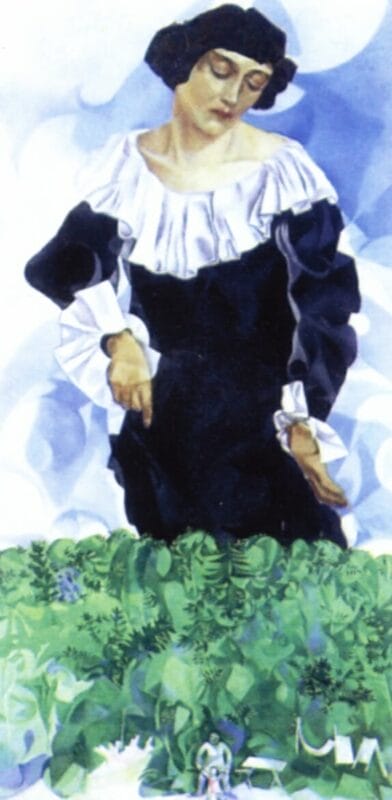You may not yet be familiar with the name Marc Chagall, but his masterful and whimsical paintings helped pioneer modern art in the early 20th century. As one of the most acclaimed artists of the modernist era, Chagall’s fantastical and dream-like art explored color and form in groundbreaking ways. His paintings depicted an imaginary world of folklore and fantasy that incorporated surreal and whimsical elements. Chagall was born in Russia but spent much of his life in France, and his art was influenced by the artistic movements in both countries, including Primitivism, Cubism, and Fauvism. However, Chagall’s style remained distinctly his own. His oeuvre spanned many decades and media, including painting, printmaking, illustration, stained glass, tapestry, and ceramics. Chagall lived to the age of 97, witnessing the global recognition of his art and cementing his status as a seminal figure in modern art.

Chagall’s Artistic Style and Influences
As an early modernist painter, Marc Chagall’s artistic style was influenced by several major art movements of the early 20th century, including Primitivism, Fauvism, and Surrealism.
Primitivism, with its focus on folklore and naïve, childlike expressions, inspired Chagall to incorporate elements of Russian folk art in his paintings. This included the use of intense colors and simplification of forms.
The Fauvist movement, emphasizing the expressive use of vibrant color, also significantly influenced Chagall’s use of bold, unnaturalistic colors to evoke emotion. His paintings are characterized by a dreamy, fantastical quality featuring deep blue and green tones contrasted with bright red, yellow and pink.
Surrealism had a more subtler influence on Chagall’s style. Like the Surrealists, Chagall aimed to create illogical scenes and juxtapositions in a semi-realistic style. His paintings often depict whimsical, floating figures and objects that are not bound by the laws of physics. However, Chagall rejected the dark, psychoanalytical themes of Surrealist art, instead painting scenes of love, joy and Jewish village life.
Through skillfully combining multiple influences, Chagall crafted his own distinct style. His masterful use of color and poetic, whimsical scenes made him one of the most prominent figures in 20th-century art. Chagall’s paintings depicting love and Jewish folklore have resonated with art lovers worldwide, cementing his status as a pioneer of modern art.

Key Themes in Chagall’s Paintings
As an early pioneer of modern art, Marc Chagall’s paintings explored several key themes throughout his long career.
One central theme was his Russian and Jewish heritage. Born in Belarus, Chagall’s works incorporated imagery from Russian folklore and Jewish religious traditions. His vivid and whimsical style combines fantasy and spirituality, as seen in works like “I and the Village” (1911) which juxtaposes images of peasants and farm animals with a personification of the Eternal Jew.
Another theme was love and romance. Chagall’s paintings often depicted tender moments between couples, using a dreamy and poetic style. Works like “Birthday” (1915) and “The Dream” (1910) portray affectionate lovers in mid-air, conveying a sense of euphoria and bliss. For Chagall, love seemed to transcend the physical world.
Finally, Chagall explored man’s inhumanity to man. While less common in his oeuvre, some paintings reflected the sorrows of war and oppression. His 1938 work “White Crucifixion” shows Jesus on the cross wearing a Jewish prayer shawl, a solemn statement about the suffering of Jews in Europe at the time.
Through colorful dreamscapes and poignant subjects, Chagall pushed the boundaries of modern art. His masterful and imaginative paintings gave visual expression to timeless themes of spirituality, love, and human suffering. More than 100 years later, Chagall’s genre-blending works remain endlessly enchanting.
Chagall’s Role in the Modern Art Movement
Marc Chagall was a pioneer of modern art in the early 20th century. Through his expressive and dreamlike paintings, Chagall helped establish modernism as a prominent artistic style.
Rejection of Realism
Like other modern artists of his time, Chagall rejected the realism that dominated 19th century art. He abandoned the idea that art should accurately depict the visual world. Instead, his paintings portrayed imaginary dreamscapes with a whimsical and fantastical quality. His work demonstrated that art could be emotive, symbolic, and abstract rather than merely representational.
Influence of Fauvism and Cubism
Chagall was influenced by contemporary art movements such as Fauvism and Cubism. From Fauvism, he adopted the expressive use of color and loose brushstrokes. His paintings have a vibrant and decorative quality with colors that are intensified rather than naturalistic. Chagall was also influenced by the flattened forms, geometric shapes, and multiple perspectives of Cubism, though he adapted these in his own imaginative style.
Depictions of Jewish Folklore
Much of Chagall’s work was inspired by his Russian-Jewish heritage and the folklore of his youth in Vitebsk, Belarus. His paintings incorporated symbolic images from Jewish mysticism and featured figures from Jewish folk tales and the Torah, such as musicians, scholars, and animals. By fusing these Jewish subjects with a modern artistic style, Chagall created a uniquely personal genre that celebrated his cultural identity.
Through these qualities, Chagall helped establish a new vocabulary of modern art that was imaginative, symbolic, and drew on themes of cultural identity. His legacy as a pioneer of modernism lives on in his radiant and whimsical paintings. Chagall demonstrated how modern art could be deeply personal, poetic, and expand beyond the limits of realism.

Chagall’s Most Famous Works
The Blue Rider (Der Blaue Reiter)
Painted in 1903, The Blue Rider is one of Chagall’s earliest major works. This dreamlike scene features a mysterious blue rider galloping through a nighttime forest. The whimsical and fantastical quality of the painting is characteristic of Chagall’s unique artistic style that blended aspects of Cubism, Fauvism, and Russian folk art.
I and the Village
Completed in 1911, I and the Village is considered Chagall’s first mature work of art. This nostalgic painting depicts memories of his childhood hometown in Belarus. Chagall portrays vivid scenes of village life, including a milkmaid, farmers, and livestock. The whimsical and fanciful style showcases overlapping images and non-naturalistic colors. I and the Village established Chagall as an avant-garde artist and pioneer of modern art.
The Fiddler
Painted in 1912, The Fiddler is one of Chagall’s most recognizable works. This dreamy and lyrical painting features a fiddler surrounded by a night sky, rooftops, and a glowing moon. The fiddler seems to float in the air as he plays his violin, evoking a sense of joy, music, and dance. The whimsical and poetic nature of the work demonstrates Chagall’s ability to turn memories and dreams into visual art.
The Three Candles
Created in 1938, The Three Candles is a gouache and oil painting depicting a sense of hope. The painting shows three lit candles glowing in the night, each in a different color. The candles symbolize faith, hope, and love. Although Chagall painted this work in response to the rise of Fascism in Europe, the message of optimism and resilience in the face of darkness is timeless.
Chagall produced many other famous masterpieces over his long and prolific career. Some additional notable works include Bride with Eiffel Tower, The Dream, and Chagall’s ceiling at the Paris Opera Garnier. Chagall’s imaginative and joyful paintings have established him as a pioneer of modern art and one of the most successful artists of the 20th century.
Where to View Chagall’s Paintings

Major Museums
Some of the best collections of Chagall’s works can be found in major art museums around the world. The Museum of Modern Art in New York City has a substantial collection of Chagall’s paintings, drawings, costumes, and stained glass. The Art Institute of Chicago, Philadelphia Museum of Art, and Tate Modern in London also house impressive collections of Chagall’s paintings spanning different periods of his career.
Chagall Museums
For the most comprehensive collections, visit one of the Marc Chagall museums dedicated solely to the artist and his works. The Marc Chagall National Museum in Vitebsk, Belarus houses over 300 works including paintings, drawings, ceramics, and sculptures. The Chagall Museum in Nice, France contains Chagall’s 17 large biblical paintings, as well as mosaics and gouaches. The Chagall Museum of the Marc Chagall Biblical Message in Vence, France is home to Chagall’s monumental work entitled “The Message Biblique.”
Stained Glass Windows
Some of Chagall’s most striking creations are his stained glass windows. Majestic examples can be seen at several churches and chapels in France. The Fraumünster church in Zurich, Switzerland houses five stunning Chagall windows. Chagall’s twelve stained glass windows at Hadassah Hospital in Jerusalem, Israel depict the twelve tribes of Israel. The America Windows at the Art Institute of Chicago comprise Chagall’s only work in stained glass created for a secular setting.
Viewing Chagall’s masterful paintings, drawings, and stained glass in person offers a glimpse into the imaginative and whimsical world created by this pioneer of modern art. His works continue to inspire new generations of artists and art lovers around the globe. Exploring the museums and locations that house Chagall’s creations provides a unique opportunity to fully appreciate the scope of his artistic vision.
As you learned, Marc Chagall was an influential pioneer of modern art whose whimsical and dreamy style broke from artistic conventions. His paintings are a testament to the power of imagination and his persistent spirit of nonconformity. Chagall followed his artistic vision and passions, fusing fantasy and nostalgia with hints of Jewish folklore and mysticism. His masterful use of color and metaphorical language of images allowed him to create an entirely new visual vocabulary. Though controversial during his time, Chagall’s oeuvre has stood the test of time and today he is regarded as one of the most prominent figures of 20th century art. Let his life and works be an inspiration – follow your dreams and creative spirit without limits. Break free from the ordinary and mundane, and paint your own world with the colors of imagination.









